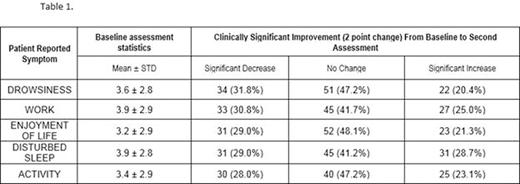Abstract
BACKGROUND: In patients with hematologic malignancies symptoms related to the disease and its treatment remain a major problem in patient care. With the advent of new treatment including immunotherapy and targeted therapies the potential for prolonged life and additional treatment is increasing. Patient self-reported symptom burden during periods of observation and treatment are infrequently reported but highly relevant to patient care. Assessment of patient-reported outcomes may allow for improvement in the management of symptoms and communication with providers.
The Symptom Inventory Tool (SIT) is an assessment tool that captures patient's perceived symptom burden for real-time clinical intervention, taken at baseline and every 21 days or greater. It is comprised of 19 questions from the validated M.D. Anderson SIT (MDASI) (Cleeland CS, Cancer 2013.) and 8 additional questions added by CTCA for additional evaluation of patient symptoms.
PATIENTS & METHODS:
Patients reported symptoms intensity using the SIT: 19-item MDASI and 8 additional questions added by CTCA (constipation, swelling, mouth soreness, bleeding, sexual interest, family, hope & overall QOL). Symptoms were rated "at the worst" on an 11-point numeric scale ranging from 0 ('none present") to 10 ("as bad as you can imagine") in the previous 24 hours. SIT became an integral part of patient care at CTCA beginning in 2012.
RESULTS: From 2012 to 2016, a total of 230 patients diagnosed with hematologic malignancies were evaluated at CTCA-ERMC. 108 patients that had two or more SIT data points were selected for analysis. A total of 830 assessments were analyzed. The assessments consisted of 108 completed at baseline, 107 completed at the 2nd follow-up, and 613 at 3rd follow-up or greater. Median age was 51 years (range, 18-78). Race: white (65%) black (32%) and other (2%). The average time since diagnosis was 41 months, and 32% of the patients had received prior systemic therapy. Table 1 shows the 5 most reported symptoms of entire sample with approximately 30% reported improvement from the baseline to the second assessment. Table 2 shows a subset of 35 patients that reported severe scores of > 8 for five symptoms that had clinically significant improvement from baseline to 2nd assessment.
CONCLUSIONS: The SIT was successful in identifying symptom burden and interference with life issues in patients with hematologic malignancies. Early identification of patient symptom burden may allow for faster intervention and improvement in patient outcomes.
No relevant conflicts of interest to declare.
Author notes
Asterisk with author names denotes non-ASH members.



This feature is available to Subscribers Only
Sign In or Create an Account Close Modal